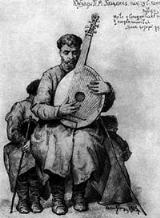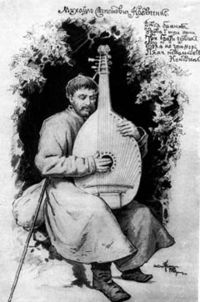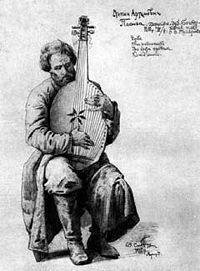
Opanas Slastion
Encyclopedia
Opanas Georgievych Slastion (1855 — 1933) was a Ukrainian
graphic artist, painter and ethnographer.
He was born in the Ukrainian
port town of Berdyansk on the Berdyansk Gulf of the Sea of Azov
. He studied at the Imperial Academy of Arts in Saint Petersburg
, Russia
(where he was also known as Afanasy Slastyon), researched the Cossack
documents in the archives of the Imperial Russian
ministry of defense, and later worked as a teacher at the Arts and Crafts School (later renamed the State Ceramics Vocational School) in Myrhorod
, Ukraine
. A very gifted person, he perfected his talents in singing, bandura
playing, ethnography
, journalism, education, design, and architecture
. Opanas Slastion was a true Ukrainian encyclopaedist.

. Many gifted Ukrainian performers joined court choirs and theatre, opera
, and ballet
troupes, and the Ukrainian artists were attracted to the Academy of Arts in St. Petersburg. In the 19th century among these Ukrainian artists was the famous poet and writer Taras Shevchenko
, whose writings, etching
s and paintings dedicated to Ukrainian ethnographic themes (genre scenes and portraits) greatly influenced Slastion, who became the first illustrator of Shevchenko's 'Kobzar
' (the illustrations to "Haidamaky"). As a painter, Slastion is credited with depicting series of Cossack
and kobzar
portraits and scenes of Ukrainian country life.

s. Actually, he himself was the first outstanding sighted bandura
player and tutor of modern times. Kobzar Ivan Kuchuhura Kucherenko
stayed with him in Myrhorod in order to refine his performance of dumy
(sung epic poems) under the guidance of Slastion. Danylo Pika, one of the founders of the Poltava Bandurist Capella
(who became its conductor), initially learned to play the bandura
from Slastion in Myrhorod. Later in his life, in the early 1930s, Slastion designed the shape of the standard Kiev bandura (the familiar modern shape of the instrument). Some other instruments of the bandura family (such as those made by Ivan Skliar, for example) were also modeled on Slastion's designs.
In 1876 P. Martynovych and his colleague Slastion travelled to Lokhvytsia
and recorded the duma
parody by kobzar Ivan Kravchenko. In 1887 Slastion made an engraving of kobzar P. Siroshtan.
In 1905 he painted a portrait of kobzar Pavlo Hashchenko
and noted that Hashchenko knew four dumy. In 1906 Slastion met the kobzar Zhovniansky, recorded his performances of dumy, and painted his portrait.
 In 1908 in Yalta
In 1908 in Yalta
the technically savvy Slastion helped Lesia Ukrainka and her husband Klyment Kvitka make live recordings (on phonograph
cylinders) of the dumy performed by the blind virtuoso
Hnat Honcharenko
(circa 1837 - circa 1917). These recordings were transcribed by Filaret Kolessa
, who later published them in his collection Melodiyi ukrayins'kykh narodnykh dum (The Melodies of the Ukrainian Folk Dumas). It is known that Slastion corresponded with another well-known blind kobzar, Tereshko Parkhomenko
(1872–1910). In 1909 Slastion made recordings of the repertoire of kobzar Hovtan, including the duma "The Widow and Her Three Sons".
Selections from Slastion's repertoire originally recorded on wax cylinders can be found on a record released as a dedication to Lesia Ukrainka.
As an architect, Opanas Slastion was one of the founding fathers of the "Ukrainian Modern" style in architecture.
Ukrainians
Ukrainians are an East Slavic ethnic group native to Ukraine, which is the sixth-largest nation in Europe. The Constitution of Ukraine applies the term 'Ukrainians' to all its citizens...
graphic artist, painter and ethnographer.
He was born in the Ukrainian
Ukraine
Ukraine is a country in Eastern Europe. It has an area of 603,628 km², making it the second largest contiguous country on the European continent, after Russia...
port town of Berdyansk on the Berdyansk Gulf of the Sea of Azov
Sea of Azov
The Sea of Azov , known in Classical Antiquity as Lake Maeotis, is a sea on the south of Eastern Europe. It is linked by the narrow Strait of Kerch to the Black Sea to the south and is bounded on the north by Ukraine mainland, on the east by Russia, and on the west by the Ukraine's Crimean...
. He studied at the Imperial Academy of Arts in Saint Petersburg
Saint Petersburg
Saint Petersburg is a city and a federal subject of Russia located on the Neva River at the head of the Gulf of Finland on the Baltic Sea...
, Russia
Russia
Russia or , officially known as both Russia and the Russian Federation , is a country in northern Eurasia. It is a federal semi-presidential republic, comprising 83 federal subjects...
(where he was also known as Afanasy Slastyon), researched the Cossack
Cossack
Cossacks are a group of predominantly East Slavic people who originally were members of democratic, semi-military communities in what is today Ukraine and Southern Russia inhabiting sparsely populated areas and islands in the lower Dnieper and Don basins and who played an important role in the...
documents in the archives of the Imperial Russian
Russian Empire
The Russian Empire was a state that existed from 1721 until the Russian Revolution of 1917. It was the successor to the Tsardom of Russia and the predecessor of the Soviet Union...
ministry of defense, and later worked as a teacher at the Arts and Crafts School (later renamed the State Ceramics Vocational School) in Myrhorod
Myrhorod
Myrhorod or Mirgorod is a city in the Poltava Oblast of central Ukraine. Serving as the administrative center of the Myrhorodskyi Raion , the city itself is also designated as a separate raion within the oblast, and is located on the river Khorol.-History:The town was founded either in the 12th...
, Ukraine
Ukraine
Ukraine is a country in Eastern Europe. It has an area of 603,628 km², making it the second largest contiguous country on the European continent, after Russia...
. A very gifted person, he perfected his talents in singing, bandura
Bandura
Bandura refers to a Ukrainian plucked string folk instrument. It combines elements of a box zither and lute, as well as its lute-like predecessor, the kobza...
playing, ethnography
Ethnography
Ethnography is a qualitative method aimed to learn and understand cultural phenomena which reflect the knowledge and system of meanings guiding the life of a cultural group...
, journalism, education, design, and architecture
Architecture
Architecture is both the process and product of planning, designing and construction. Architectural works, in the material form of buildings, are often perceived as cultural and political symbols and as works of art...
. Opanas Slastion was a true Ukrainian encyclopaedist.

Ukraine at the turn of the 19-20th centuries
At the time Slastion was growing up, there were opportunities for some Ukrainians to have their talents recognized in the Imperial capital and in Western EuropeEurope
Europe is, by convention, one of the world's seven continents. Comprising the westernmost peninsula of Eurasia, Europe is generally 'divided' from Asia to its east by the watershed divides of the Ural and Caucasus Mountains, the Ural River, the Caspian and Black Seas, and the waterways connecting...
. Many gifted Ukrainian performers joined court choirs and theatre, opera
Opera
Opera is an art form in which singers and musicians perform a dramatic work combining text and musical score, usually in a theatrical setting. Opera incorporates many of the elements of spoken theatre, such as acting, scenery, and costumes and sometimes includes dance...
, and ballet
Ballet
Ballet is a type of performance dance, that originated in the Italian Renaissance courts of the 15th century, and which was further developed in France and Russia as a concert dance form. The early portions preceded the invention of the proscenium stage and were presented in large chambers with...
troupes, and the Ukrainian artists were attracted to the Academy of Arts in St. Petersburg. In the 19th century among these Ukrainian artists was the famous poet and writer Taras Shevchenko
Taras Shevchenko
Taras Hryhorovych Shevchenko -Life:Born into a serf family of Hryhoriy Ivanovych Shevchenko and Kateryna Yakymivna Shevchenko in the village of Moryntsi, of Kiev Governorate of the Russian Empire Shevchenko was orphaned at the age of eleven...
, whose writings, etching
Etching
Etching is the process of using strong acid or mordant to cut into the unprotected parts of a metal surface to create a design in intaglio in the metal...
s and paintings dedicated to Ukrainian ethnographic themes (genre scenes and portraits) greatly influenced Slastion, who became the first illustrator of Shevchenko's 'Kobzar
Kobzar
A Kobzar was an itinerant Ukrainian bard who sang to his own accompaniment.-Tradition:Kobzars were often blind, and became predominantly so by the 1800s...
' (the illustrations to "Haidamaky"). As a painter, Slastion is credited with depicting series of Cossack
Cossack
Cossacks are a group of predominantly East Slavic people who originally were members of democratic, semi-military communities in what is today Ukraine and Southern Russia inhabiting sparsely populated areas and islands in the lower Dnieper and Don basins and who played an important role in the...
and kobzar
Kobzar
A Kobzar was an itinerant Ukrainian bard who sang to his own accompaniment.-Tradition:Kobzars were often blind, and became predominantly so by the 1800s...
portraits and scenes of Ukrainian country life.

Slastion and the kobzars
Slastion was one of the most active propagators of the artistry of the kobzarKobzar
A Kobzar was an itinerant Ukrainian bard who sang to his own accompaniment.-Tradition:Kobzars were often blind, and became predominantly so by the 1800s...
s. Actually, he himself was the first outstanding sighted bandura
Bandura
Bandura refers to a Ukrainian plucked string folk instrument. It combines elements of a box zither and lute, as well as its lute-like predecessor, the kobza...
player and tutor of modern times. Kobzar Ivan Kuchuhura Kucherenko
Ivan Kuchuhura Kucherenko
Ivan Iovych Kuchuhura-Kucherenko Ivan Iovych Kuchuhura-Kucherenko Ivan Iovych Kuchuhura-Kucherenko (July 7, 1878—November 24, 1937 was a Ukrainian minstrel (kobzar) and one of the most influential kobzars of the early 20th century...
stayed with him in Myrhorod in order to refine his performance of dumy
Duma (epic)
A Duma is a sung epic poem which originated in Ukraine during the Hetmanate Era in the sixteenth century...
(sung epic poems) under the guidance of Slastion. Danylo Pika, one of the founders of the Poltava Bandurist Capella
Poltava Bandurist Capella
The Poltava Bandurist Capella was vocal-instrumental ensemble who accompanied themselves on the multi-stringed Ukrainian bandura. It was initially established in February 1925, based on a male church choir who sang in the Ukrainian Autocephalous Orthodox Cathedral in Poltava under the direction of...
(who became its conductor), initially learned to play the bandura
Bandura
Bandura refers to a Ukrainian plucked string folk instrument. It combines elements of a box zither and lute, as well as its lute-like predecessor, the kobza...
from Slastion in Myrhorod. Later in his life, in the early 1930s, Slastion designed the shape of the standard Kiev bandura (the familiar modern shape of the instrument). Some other instruments of the bandura family (such as those made by Ivan Skliar, for example) were also modeled on Slastion's designs.
Slastion the ethnographer
Slastion was also a leading Ukrainian folklorist and ethnographer. In 1875, then a student at the Petersburg Academy of Arts and a budding folklorist, he spent his holidays in Ukraine and got the chance to know the artistry of the kobzar Nekhovaizub.In 1876 P. Martynovych and his colleague Slastion travelled to Lokhvytsia
Lokhvytsia
Lokhvytsia is a city in the Poltava Oblast of central Ukraine. It is the administrative center of the Lokhvytskyi Raion , and is located on the banks of Lokhvytsia River.The current estimated population is around 21,400 ....
and recorded the duma
Duma (epic)
A Duma is a sung epic poem which originated in Ukraine during the Hetmanate Era in the sixteenth century...
parody by kobzar Ivan Kravchenko. In 1887 Slastion made an engraving of kobzar P. Siroshtan.
In 1905 he painted a portrait of kobzar Pavlo Hashchenko
Pavlo Hashchenko
Pavlo Ivanovych Hashchenko was a Ukrainian kobzar and bandura player.Hashchenko was originally from Poltava province but lived most of his life in the village of Konstantynivka, Bohodukhiv county, Kharkiv province....
and noted that Hashchenko knew four dumy. In 1906 Slastion met the kobzar Zhovniansky, recorded his performances of dumy, and painted his portrait.

Yalta
Yalta is a city in Crimea, southern Ukraine, on the north coast of the Black Sea.The city is located on the site of an ancient Greek colony, said to have been founded by Greek sailors who were looking for a safe shore on which to land. It is situated on a deep bay facing south towards the Black...
the technically savvy Slastion helped Lesia Ukrainka and her husband Klyment Kvitka make live recordings (on phonograph
Phonograph
The phonograph record player, or gramophone is a device introduced in 1877 that has had continued common use for reproducing sound recordings, although when first developed, the phonograph was used to both record and reproduce sounds...
cylinders) of the dumy performed by the blind virtuoso
Virtuoso
A virtuoso is an individual who possesses outstanding technical ability in the fine arts, at singing or playing a musical instrument. The plural form is either virtuosi or the Anglicisation, virtuosos, and the feminine form sometimes used is virtuosa...
Hnat Honcharenko
Hnat Honcharenko
Hnat Tykhonovych Honcharenko was one of the most renowned Ukrainian kobzars of the Kharkiv oblast of the late 19th and early 20th centuries.- Biography :...
(circa 1837 - circa 1917). These recordings were transcribed by Filaret Kolessa
Filaret Kolessa
Filaret Mykhailovych Kolessa was a Ukrainian ethnographer, folklorist, composer, musicologist and literary critic. He was a member of the Shevchenko Scientific Society from 1909, The Free Ukrainian Academy of Sciences from 1929, and the founder of Ukrainian ethnographic musicology.- Biography...
, who later published them in his collection Melodiyi ukrayins'kykh narodnykh dum (The Melodies of the Ukrainian Folk Dumas). It is known that Slastion corresponded with another well-known blind kobzar, Tereshko Parkhomenko
Tereshko Parkhomenko
Terentiy Makarovych Parkhomenko was one of the most respected kobzars of the late 19th and early 20th century.-Biography:...
(1872–1910). In 1909 Slastion made recordings of the repertoire of kobzar Hovtan, including the duma "The Widow and Her Three Sons".
Selections from Slastion's repertoire originally recorded on wax cylinders can be found on a record released as a dedication to Lesia Ukrainka.
As an architect, Opanas Slastion was one of the founding fathers of the "Ukrainian Modern" style in architecture.

